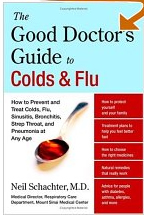
The Good Doctor's Guide to Colds and Flu
Shots or Not? The Plague, the Flu, and You
Reprinted with permission from Orthomolecular Medicine News Service
(OMNS, October 27, 2009)
Swine flu. Bird flu. The media has everyone worrying about epidemics and pandemics. Yet there is nothing said about one of the great communicable diseases of all time: the plague. The Black Death. No, it is not extinct. There are new cases of plague in the United States every year, totaling over 400 cases since 1950. And yes, there is a vaccination for it.
So have you had your plague shot? You haven't?
Why isn't your doctor urging you to get one? Do you know anyone who has had a plague vaccination? Then why is there no plague epidemic? And why is vaccination supposedly the only way to stop a flu epidemic?
Disease Comparison: Viral vs Bacterial
One proffered explanation is that the diseases are dissimilar, because influenza is viral, and plague is bacterial. But tetanus is bacterial, and we aggressively vaccinate against that. Indeed, the CDC specifies a considerable number of Vaccine Preventable Diseases which are bacterial, including:
- Anthrax
- Bacterial meningitis
- Diphtheria
- Haemophilus influenzae serotype b
- Pertussis (whooping cough)
Plague is not even on the CDC's list. The Black Death, the disease that killed at least a quarter of Europe, hasn't even made the list of Vaccine-Preventable Diseases.
Current Plague Statistics
Worldwide
Over 2,000 cases and hundreds of deaths annually
United States
10-15 cases per year (mostly in Southwest)
CDC states that "persons who have regular contact with wild rodents or their fleas" in areas where plague has occurred should be vaccinated. That includes contact with squirrels, mice, rabbits, coyotes, woodchucks, cats, and dogs—all of which carry fleas. Fleas are found everywhere. Then why isn't plague everywhere?
Climate and Geographic Factors
One explanation is that plague is climate-related. If incidence were related merely to heat, we might expect cases in Florida, Georgia, Louisiana, and Alabama. But there aren't. If plague is temperature-dependent, it's confusing: almost all USA cases are in the warm, dry Southwest, yet plague decimated Europe in the 1300s—much cooler than the American southwest.
The Historical Perspective
What is striking about the plague is that it is still around and practically no one gets it. This disease killed 50 million people. Eventually, the great Black Death epidemic ended. Somehow. The epidemics were not stopped by:
- Killing every flea, rodent, or house pet
- Antibiotics (not available)
- Mass vaccination (not available)
The Key Question
If you, and the entire population of the USA, are not vaccinated against the plague, why doesn't it spread now in 2009 the way it spread in the past, killing at least one in four?
Generally, improved sanitation and improved nutrition are credited with such a victory.
If these work with plague, they might make a rather big impact on the flu.
Alternative Approaches to Flu Prevention
Flu shots can have serious side effects and are largely ineffective.
There is a ready alternative: to build up our immune systems, we can utilize large, orthomolecular doses of nutrients.
Nutrients That Reduce Flu Duration and Severity:
Many physicians consider high doses of vitamin C to be so powerful an antiviral that it may be considered the "other" immunization for a variety of influenza strains.
Flu shots are big news, and not a few would say that they are big business. But there has been no governmental push whatsoever for plague vaccination. How come we supposedly need one shot and not the other?
Nutritional Medicine is Orthomolecular Medicine
Orthomolecular medicine uses safe, effective nutritional therapy to fight illness.
For more information: www.orthomolecular.org
The peer-reviewed Orthomolecular Medicine News Service is a non-profit and non-commercial informational resource.
Editorial Review Board:
Carolyn Dean, M.D., N.D.
Damien Downing, M.D.
Michael Gonzalez, D.Sc., Ph.D.
Steve Hickey, Ph.D.
James A. Jackson, PhD
Bo H. Jonsson, MD, Ph.D
Thomas Levy, M.D., J.D.
Jorge R. Miranda-Massari, Pharm.D.
Erik Paterson, M.D.
Gert E. Shuitemaker, Ph.D.
Andrew W. Saul, Ph.D., Editor and contact person.
Email: [email protected]
To Subscribe at no charge: Subscribe Here
The above provides a general overview of this topic and may not apply to everyone. Any treatment protocol should be discussed with a qualified healthcare practitioner. Please refer to: Medical & Legal Disclaimer.